While ovens and hobs may top the appliance shopping list for consumers who want to achieve ‘restaurant’ cuisine, few may consider that the dishwasher is also essential for professional results in a domestic kitchen.
Providing clean pots, pans, plates, glasses and cutlery, the dishwasher is a behind-the-scenes workhorse, making food look good enough to eat.
Yet the UK still lags far behind its European neighbours in realising the importance of the dishwasher at home.
Sponsored Video
Brand manager for Whirlpool Catherine Balderson points out:
“According to Euromonitor International, dishwasher penetration here in in the UK currently sits at 43.1%, an increase from 41.5% in 2016. In the UK the number of consumers owning a dishwasher is still relatively low compared to countries such as France and Germany, where penetration sits at 75.3% and 54.9% respectively.”

Measuring 450mm wide, the WC480 fully integrated dishwasher features 10 place settings and uses 9 litres of water. It has eight wash programmes, including three automatic options and a Quick Wash, as well as Glassguard wine supports – CDA
Wide demographic base
While this may seem disappointing at first, it continues to mean there is room for sale growth and the consumer demographic base is far and wide.
Interestingly, the majority of purchases are made by experienced, older consumers.
Head of brand at Hotpoint Jennifer Taylor confers: “Research conducted in July 2017 has found out that 57% of dishwasher purchases that were made in the UK were by consumers aged between 45 and 60 years.”

Featuring 3D Wash technology, which uses five independent water jets, the Hotpoint Ultima HIO) 3P23 WL E dishwasher has 15 place settings. It has upper basket adjustment and a cutlery tray – Hotpoint

Part of its Professional+ Collection, the IGVE 6610 integrated dishwasher caters for 15 place settings. It features touch-to-open technology and offers six washing programmes, including Fast with a duration of 20 minutes- Kupperbusch
However, those who are younger may have grown up with a dishwasher, therefore it is seen as an essential appliance.
Added to which, the newbuild market where the dishwasher is considered essential in specification, opens an avenue for replacement purchases down the line, when the appliances have reached end of life.
It provides a wide net of potential consumers to target for dishwasher sales.
Meeting lifestyle demands
What all customers have in common, is they are seeking convenience to enhance their lifestyle.
No-one would question the inclusion of laundry appliances in a home, and with similar time-saving and energy-saving benefits applied to dishwashers, it offers a real opportunity for the savvy kitchen showroom.
After all, who would choose to wash their clothes by hand?
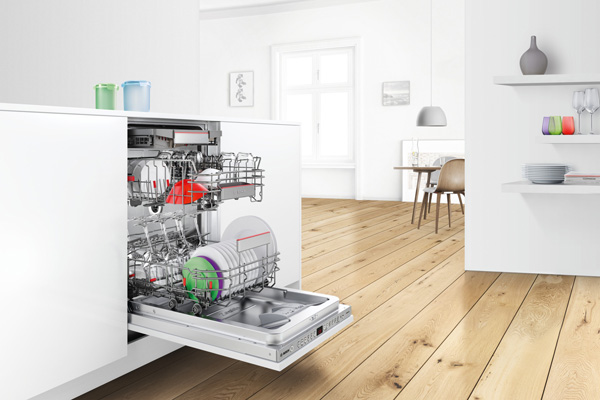
The series 6 SPV66TX01E Full Integrated Dishwasher measures 450mm wide, has a 10-place setting and uses 9.5 litres of water. It offers PerfectDry, which uses Zeolith minerals to help dry the load, has a timelight to beam the remaining programme time on the floor and EmotionLight to illuminate the cavity- Bosch
Ultimately, it is the performance of the dishwasher which will encourage consumers to part with their hard-earned cash.
Manufacturers have worked to deliver machines that are not only able to deliver hygienically clean cookware and tableware, but dry them too, at speed and using fewer resources than hand-washing.
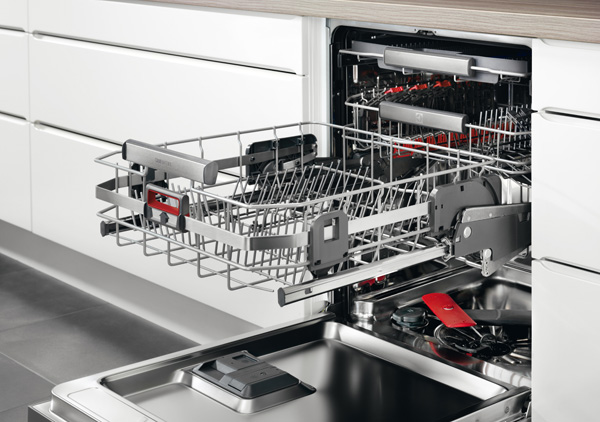
The ComfortLift dishwasher features a lower rack which can be lifted to waist height, by the pull of a lever, for ease of loading and unloading. It features eight wash programmes, room for 13-place functions, AirDry technology and a timebeam -AEG
Washing at speed
American author Laura Vanderkam, who writes about time management, life, careers and family, says US women devote on average 1.1 hours a week to washing dishes, and their male counterparts 0.7 hours.
The improved cleaning performance of dishwashers means the appliance is able to deliver better results faster.
The inclusion of high pressure jets and additional spray arms, on selected models, means there is no need for pre-rinsing and it sees a quick wash for a full load can take from less than an hour to as little as 30mins.

The G6660 SCVI dishwasher is a fully integrated model which uses 6.5 litres of water in the automatic programme. It also boasts the QuickPowerWash which offers a full wash and dry cycle in less than an hour – Miele
Assistant category manager for laundry and dishwashing at Miele Amelia Harrison-Hall comments: “Miele’s QuickPowerWash offers a full A+ rated wash and dry cycle in just 58 minutes.”
While product manager of built-in appliances at Hoover Candy Daniel Dewey adds: “Quick wash programmes are very popular with consumers, as they’re useful for dishes that are required in a hurry.”
“One of our models, the Hoover Dynamic Mega HDP 3DO62DX, offers a 24-minute rapid wash, one of the fastest available on the market.”
Lest we forget, the delay start function, which allows the dishwashing to take place when the consumer isn’t even at home!
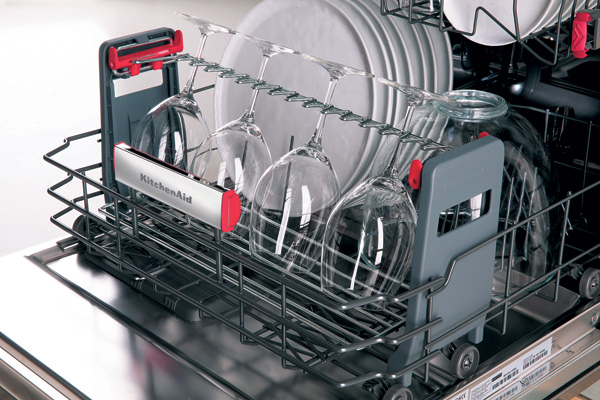
Measuring 600mm, the KDSCM 82140 UK fully integrated dishwasher has a double spray arm and a Booster programme that halves the wash cycle. It features floor lighting which indicates the cycle status and has a delay start function- KitchenAid
Reducing resource use
It should be pointed out performance is not at the expense of resource use.
Instead water, detergent and resulting energy use to wash dishes has been optimised with sensor technology.
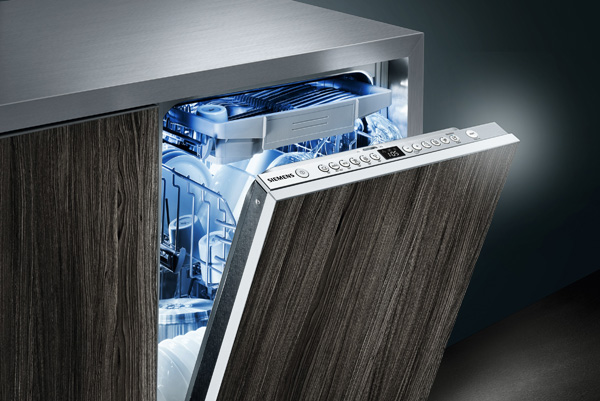
Offering the BrilliantShine feature for glasses, which includes a Shine&Dry option, the iQ500 SR656X01TE dishwasher measures 450mm. It has a 10-place setting, uses 9.5 litres of water and features adjustable VarioFlex baskets and the VarioDrawer Pro cutlery shelf- Siemens
While the use of sensors to monitor soiling and adapt water and detergent use accordingly, it’s nothing new, dishwashers are continually reducing consumption.
Saving water from the last wash for the prewash, some models use as little as six litres of water for the wash.Catherine Balderson of Whirlpool comments:
“Research conducted by Bonn University round that a Whirlpool dishwasher enables the consumer to clean over 156 items using just six litres of water, compared to the average of 103 litres of water used to wash 140 items.”
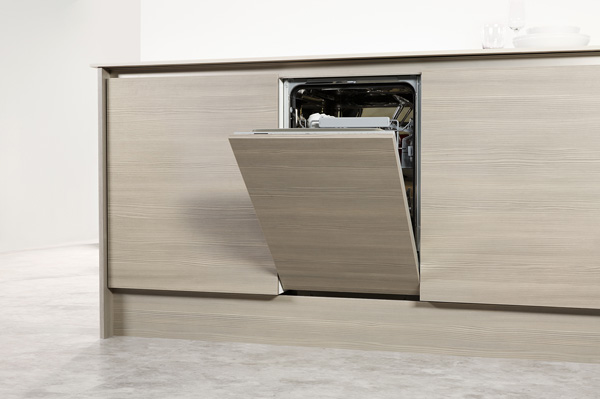
Catering for 10 place settings, the SupremeClean ADP 502 IX dishwasher uses nine litres of water. It boasts 6th Sense technology, so there is no requirement for pre-wash all within a 450mm footprint – Whirlpool
Senior product manager at Glen Dimplex Home Appliances (GDHA) ,Laura Davies, adds reduction in water usage is important in her company’s product design:
“It is estimated that, on average, washing the amount of dishes that would fill a dishwasher by hand uses 13 gallons [59 litres] of water – whereas an eco-cycle on the Belling Sensicare FDW150 only uses 10 litres of water. If that’s not a persuasive fact to use on a wavering consumer then I don’t know what is.”
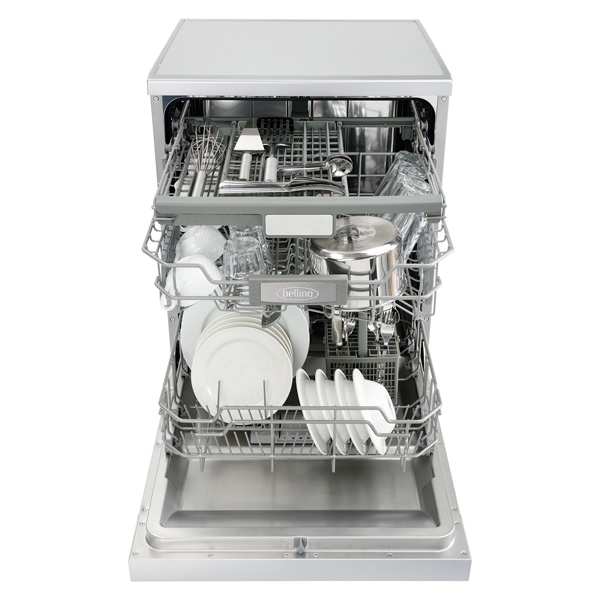
Using 10 litres of water, the Sensicare FDW150 is a 15-place setting dishwasher which boasts seven programmes. It comes with TurboDry functionality, features three wash levels, and comes in white or a stainless steel finish- Belling
Enhancements in drying performance haven’t been at the expense of energy use either. Manufacturers have looked towards automatic door opening as a means of releasing steam and allowing the contents to air dry.
Product manager at Gorenje UK Richard Mackay says: “We’re noticed an increase in features like automatic door opening. It’s excellent for quick drying with low energy consumption.”
Connectivity and voice control
Ultimately, however, it is connectivity which will see the next generation of dishwashers take resource savings to the next level.
Manufacturers have already developed complementary Apps which can help monitor energy usage, recommend programmes for optimal use of resources and also to check the machine is running correctly.
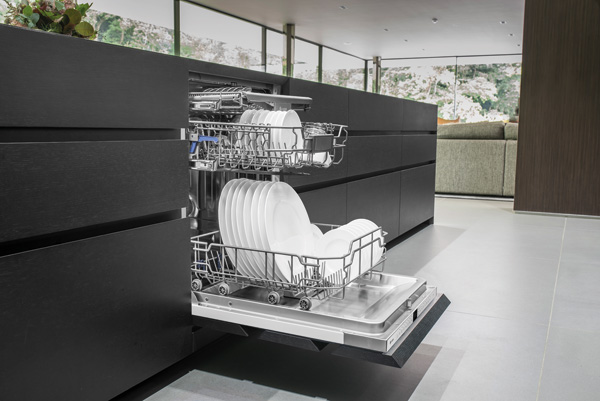
The fully integrated Di651 dishwasher has seven wash programmes, including Glass and Economy and operates using 10 litres of water. It has 15 place settings, three spray levels, an internal light and a touch control panel- Caple
Category manager of dishwashing and Smart Home at BSH Home Appliances Alex Lucas explain how technology is used in his company’s appliances:
“WiFi Home Connect dishwashers offer app-enabled features. In addition to monitoring and controls, the Home Connect app contains lots of hints and tips to help consumers understand and get the best out of their dishwasher”
“For example, users simply tell the dishwasher what they are washing and it will automatically select the correct program. By telling the app how many dishwasher tablets you bought, it will count down and send a notification when you need to buy more.”
Although connectivity is still in its infancy, manufacturers are certain it is set to gather pace in sales. Independent retail director of BSH Home Appliances Shaun English comments:
“The concept of connected appliances has been slow to develop but as IOT (the Internet of Things) gathers momentum, consumers are becoming more tech savvy and expect to engage with products in the home in new ways. So I think we can expect to see smart appliances start to take off.”
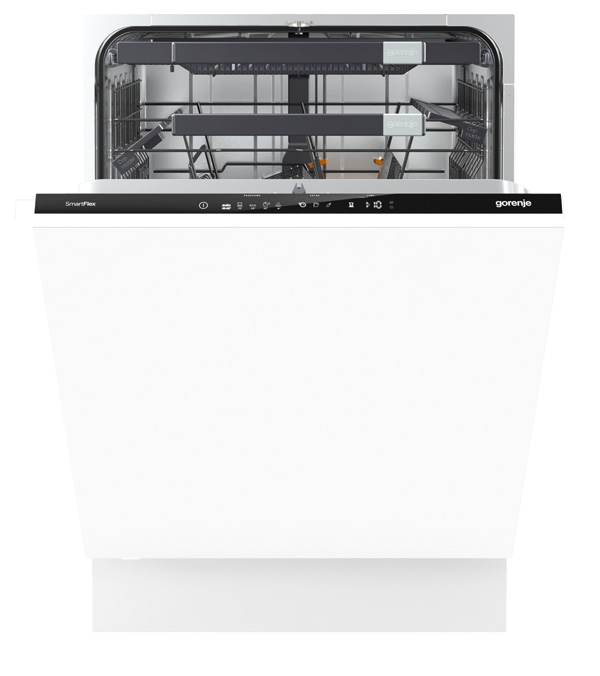
Featuring 16 place settings, the GV66260UK fully integrated dishwasher features five programmes including a Quick programme. It features Total Dry, automatic opening when the cycle has come to an end, and is operated by touch control – Gorenje
Catherine Balderson offers up some statistics:“The share of connected appliance in dishwasher remained very low in 2017, at just 1.9%. However, market analysts expect connectivity in dishwashers to gain ground over the next five years as more manufacturers introduced connected dishwashers to the market.”
Certainly marketing director of the freestanding division at Hoover Candy, Steve Macdonald points out how its connected appliances are already leading sales: “Large 16-place setting models with smart, connected technology are the fastest-growing models for us here at Hoover. This includes both WiFi and NFC connectability.”
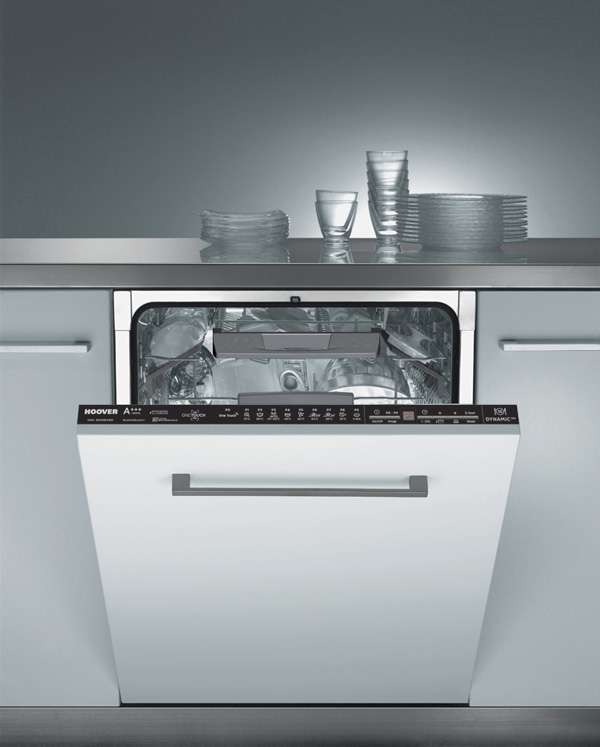
The HDI 3DO632D Fully Integrated Dishwasher features 16-place settings, 10 programmes and is NFC connected allowing the use of a smart phone or tablet to monitor and control the appliances. It features Automatic Door Opening during the dying process, so the contents can air- Hoover
With the predicted growth of virtual assistants, such as Amazon Echo, growing ownership from 9% of UK households in 2017 to 40% in 2018 (according to Radiocentre), unsurprisingly there has been focus on this control too.
Steve Macdonald of Hoover Candy continues: “As the market for virtual assistants continues to expand and develop, there’s likely to be a lot of innovation around Artificial Intelligence appliances with further product advances in voice control activation.”
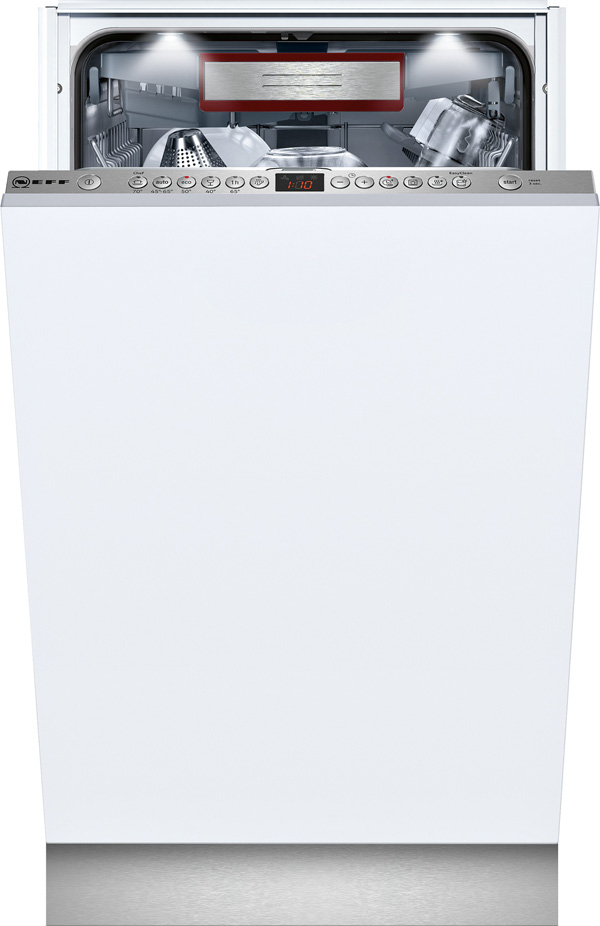
The N70 S586T60D0G Fully Integrated Dishwasher has Door Open Assistant which is push opening mechanism and a timelight which beams the programme duration onto the floor. The 450mm model features 10 place setting and has six washing programmes- Neff
Demonstrate tech in-store
The advantage of selling connected appliances for kitchen showrooms is that they have to be demonstrated to be understood, bringing consumers in-store.
Catherine Balderson agrees: “Smart technology cannot be effectively demonstrated on the internet and can only be demonstrated on the shop floor”
“This is a great opportunity for the entrepreneurial independent kitchen specialist. It provides an immense opportunity to engage and connect with the consumer and get them back into your showroom.”
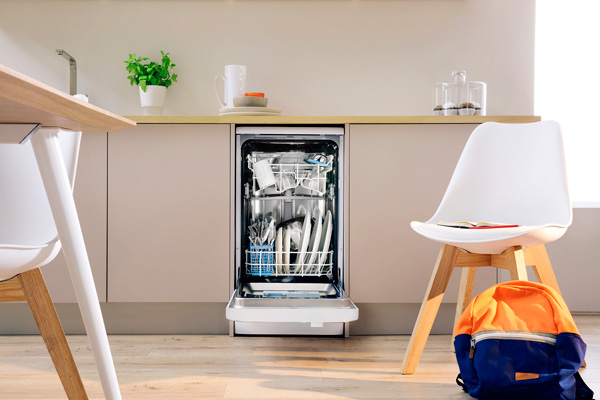
Catering for 10 place settings, the Ecotime slimline dishwasher (D5R 15B UK) features five wash programmes, including Rapid. It uses 10 litres of water and boasts a four-stage filtration system- Indesit
So take another look at dishwashers and by choosing models with the latest performance features and technology, kitchen showrooms can reap rewards.
After all, it’s important to remember for every five people who come through the doors, three won’t have a dishwasher model, so there are plenty of opportunities for sales.



